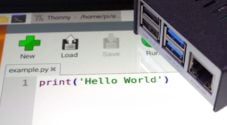In this project, we will be showing you how to install PyTorch on your Raspberry Pi.

Pytorch is a machine-learning library developed by Meta and is based on the Torch library.
You can use this library on your Raspberry Pi for natural language processing and computer vision.
Best of all, you can get decent performance from PyTorch with the Raspberry Pi, especially if you are using newer releases such as the Pi 4.
The only requirement of running Pytorch on your device is that you must be running a 64-bit operating system.
Over the following sections, we will show you how easy it is to install and use Pytorch on your Raspberry Pi.
Equipment
Below is a list of the equipment we used when we installed PyTorch on the Raspberry Pi.
Recommended
Optional
We last tested this tutorial on a Raspberry Pi 400 that was running the latest version of Raspberry Pi OS Bullseye
Preparing your Raspberry Pi for PyTorch
Before installing PyTorch, we must ensure that we have several packages already installed to our system. The main one here is Python itself.
Remember that you must be running a 64-bit operating system to install PyTorch onto the Raspberry Pi. So now is the best time to switch over if you aren’t running a 64-bit system and want to run PyTorch.
1. Your first step is to update the systems package list and upgrade any out-of-date packages.
You can perform both tasks by running the following straightforward commands in the terminal.
sudo apt update
sudo apt upgrade -yCopy2. Once the upgrade completes, we can ensure we have both Python and its package manager called pip installed to our system.
We will use “pip” later on in this guide to install PyTorch to your system.
sudo apt install python3 pip3Copy3. You can ensure you have Python installed using the command below.
python3 --versionCopyIf everything is working correctly, you should see a message similar to the one below shown within the terminal.
Python 3.9.2Installing PyTorch to the Raspberry Pi
At this point, we now have the Raspberry Pi set up and ready to install and run PyTorch.
In this section, we will install PyTorch and any other Python packages that it requires to operate.
4. Installing PyTorch to your Raspberry Pi is as straightforward as using the command below in the terminal.
We install the main part of Torch as well as its vision and audio libraries.
sudo pip3 install torch torchvision torchaudioPlease note that depending on your internet speed, this process can take a couple of minutes as PyTorch relies on several other Python libraries.
5. We also need to ensure that we have the latest version of ‘numpy‘ installed on your device.
Use the following command within your terminal to ensure the latest version is available.
sudo pip3 install numpy --upgradeTesting PyTorch is Working
With PyTorch now installed on our Raspberry Pi, we can now move on to testing that everything is working as intended.
6. Once the installation process completes, we can now check to verify it has been installed correctly.
Launch the Python interpreter by typing the command below within the terminal.
python3Copy7. With the Python interpreter now opened, we can start by importing the Torch package into the current session.
To import PyTorch, all you need to do is type “import” followed by “torch“.
import torchCopy8. If you imported PyTorch successfully, we can now grab the version by using the following line.
This line grabs the “__version__” variable specified within the Torch library.
torch.__version__CopyIf everything is working correctly, you should see the following line appear within the terminal.
With this line, you can see that we are currently running PyTorch 2.0.1 on our Raspberry Pi.
'2.0.1'Copy9. Finally, lets ensure no errors will be thrown when we go to actually run a PyTorch function.
Use the line shown below to quickly test that no errors will occur when we go to use PyTorch.
torch.Tensor([0, 0, 0])CopyBelow is the expected output after running the line above within the interpreter.
tensor([0., 0., 0.])Copy10. If everything has worked properly, you can quit Python using the command below.
quit()CopyConclusion
At this point in the tutorial, you should now have successfully installed PyTorch on your Raspberry Pi.
PyTorch is a library for Python that allows you to run various machine-learning models on your device.
Please comment below if you have issues getting this library to work on your Pi.
If you found this tutorial helpful, be sure to check out our many other Raspberry Pi projects.










Thanks for this tutorial! Worked great. Just a heads up, I had to remove the external issue manually: sudo rm -rf /usr/lib/python3.11/EXTERNALLY-MANAGED
Python and pip are kinda wonky with Debian 12.